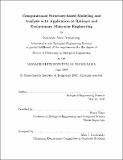| dc.contributor.advisor | Bruce Tidor. | en_US |
| dc.contributor.author | Armstrong, Kathryn Anne | en_US |
| dc.contributor.other | Massachusetts Institute of Technology. Dept. of Biological Engineering. | en_US |
| dc.date.accessioned | 2008-01-10T14:25:13Z | |
| dc.date.available | 2008-01-10T14:25:13Z | |
| dc.date.copyright | 2007 | en_US |
| dc.date.issued | 2007 | en_US |
| dc.identifier.uri | http://hdl.handle.net/1721.1/39844 | |
| dc.description | Thesis (Ph. D.)--Massachusetts Institute of Technology, Biological Engineering Division, 2007. | en_US |
| dc.description | This electronic version was submitted by the student author. The certified thesis is available in the Institute Archives and Special Collections. | en_US |
| dc.description | Includes bibliographical references (leaves 112-127). | en_US |
| dc.description.abstract | The design and development of new proteins and small molecules has considerable practical application in medicine, industry, and basic science. Frequently, progress in this area is made by altering an existing small molecule or protein for new function. This thesis presents methods for the analysis and design of rationally and evolutionarily designed molecules and focuses on applying these methods to make protein and small molecule changes more strategically. First, electrostatic analysis of a series of small molecule neuraminidase inhibitors was used to demonstrate that charge optimization improves the electrostatic component of the binding free energy, despite changes in binding mode and discrete chemical constraints. Additionally, chemical changes suggested by charge optimization frequently corresponded to tighter-binding inhibitors, indicating that this technique would be useful for the design of future inhibitors. Second, computational sequence and structure analysis were used to study the PDZ3-CRIPT binding interaction and a method for sequence analysis was developed to locate residues important for binding specificity. Third, computational analysis of the horseradish peroxidase active site suggested five positions as candidates for mutation, and further studies of new mutant enzymes let to ideas for the improvement of computational enzyme design procedures. Finally, both computational protein design techniques and a model of the evolutionary process were used to study the efficiency of evolution as a tool for creating new proteins in the laboratory. We identified sequences that serve as better evolutionary starting points that others and provide a general framework for considering the impact of protein structure on the allowed sequence space and therefore on the challenges that each protein presents to evolutionary protein engineering procedures. | en_US |
| dc.description.statementofresponsibility | by Kathryn Anne Armstrong. | en_US |
| dc.format.extent | 127 leaves | en_US |
| dc.language.iso | eng | en_US |
| dc.publisher | Massachusetts Institute of Technology | en_US |
| dc.rights | MIT theses are protected by copyright. They may be viewed, downloaded, or printed from this source but further reproduction or distribution in any format is prohibited without written permission. | en_US |
| dc.rights.uri | http://dspace.mit.edu/handle/1721.1/7582 | |
| dc.subject | Biological Engineering Division. | en_US |
| dc.title | Computational structure-based modeling and analysis with application to rational and evolutionary molecular engineering | en_US |
| dc.type | Thesis | en_US |
| dc.description.degree | Ph.D. | en_US |
| dc.contributor.department | Massachusetts Institute of Technology. Department of Biological Engineering | |
| dc.identifier.oclc | 182574662 | en_US |
